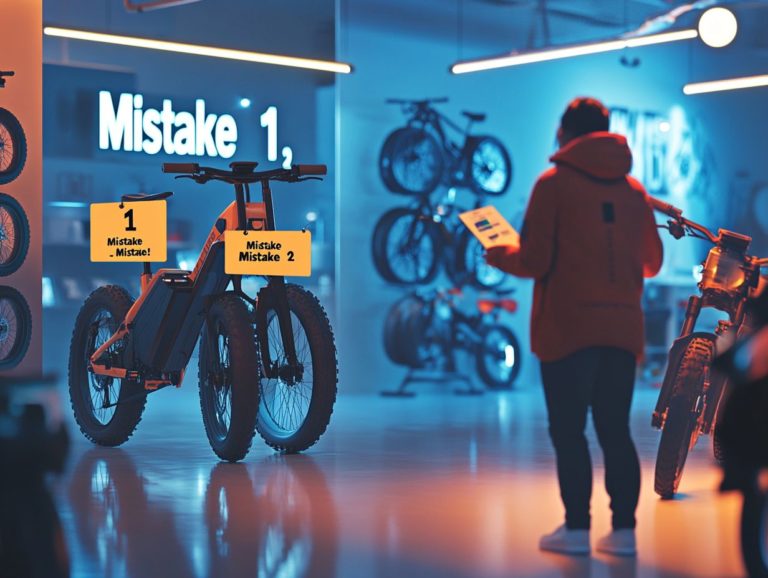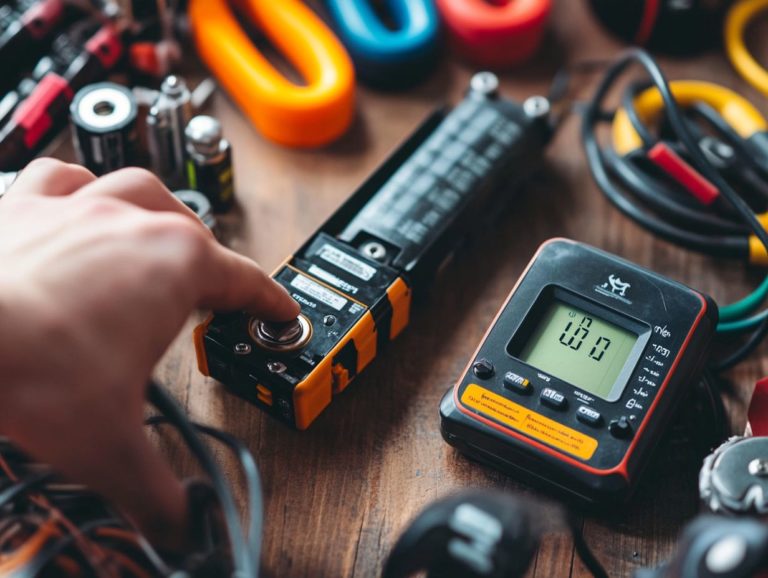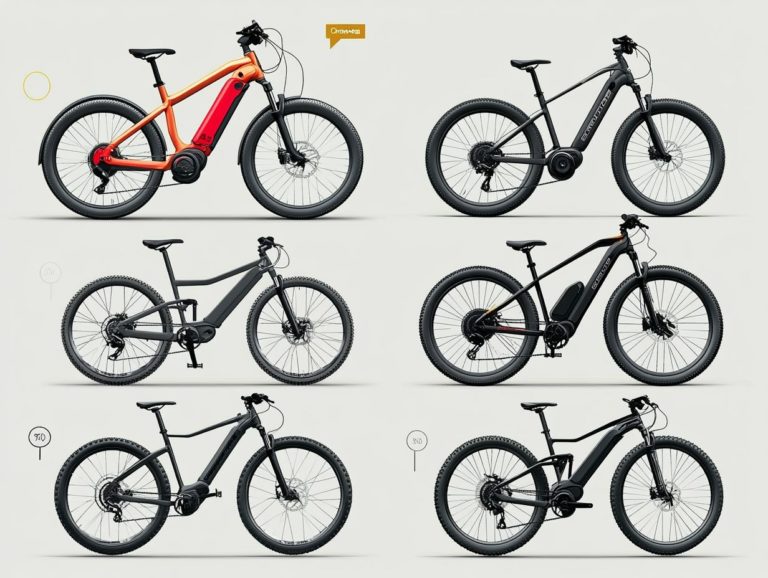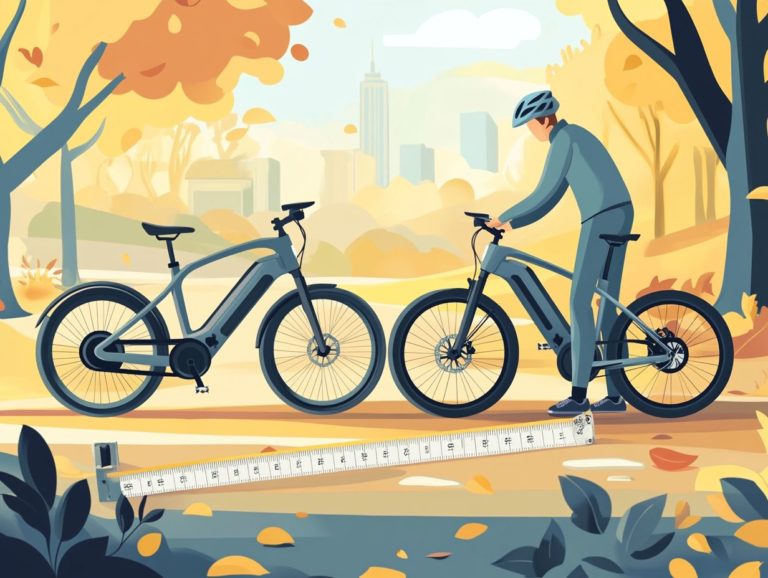5 Essential Questions About E-Bike Laws
E-bikes are quickly becoming the talk of the town. However, with their growing popularity comes a complex web of laws and regulations that can leave you scratching your head.
This article delves into five crucial questions regarding e-bike legislation. We address everything from whether these bikes qualify as motor vehicles to the licenses you may need, age restrictions, and essential safety guidelines.
You ll also discover the different classes of e-bikes, their speed limits, and tips on how to advocate for improved laws.
So, let s break down the rules, empowering you to ride with confidence and within the legal framework.
Contents
- Key Takeaways:
- 1. What Are the Current Laws and Regulations for E-Bikes?
- 2. Are E-Bikes Considered Motor Vehicles?
- 3. Do E-Bikes Require a License or Registration?
- 4. Are There Age Restrictions for Riding an E-Bike?
- 5. How Can Riders Stay Safe and Follow E-Bike Laws?
- What Are the Different Classes of E-Bikes and How Are They Regulated?
- Frequently Asked Questions
Key Takeaways:

- E-bike riders should be aware of laws and regulations, as they vary by state and can affect where and how they can ride.
- E-bikes are not considered motor vehicles, but laws regarding their use may still apply, such as speed limits and restrictions on public roads.
- Some states require a license or registration for e-bikes, while others do not. It is important to research and follow the laws in your area.
1. What Are the Current Laws and Regulations for E-Bikes?
E-bike laws and regulations can be confusing. They vary greatly from state to state. This complexity reflects different types of e-bikes, safety standards, and local traffic codes all designed to promote legal riding while supporting electric bikes as a sustainable urban transportation solution.
As an e-bike rider, grasping these regulations is crucial for navigating the legal terrain, especially in states like New York, Massachusetts, and Maryland.
E-bikes are primarily categorized into three distinct classes:
- Class 1: This type features pedal-assist only, kicking in when you pedal and stopping at speeds of 20 mph.
- Class 2: This class includes both pedal-assist and a throttle to propel the bike, also capped at 20 mph.
- Class 3: This option offers pedal-assist up to 28 mph, typically restricted to bike lanes and certain pathways.
Local authority websites offer valuable insights into specific regulations that can even vary within a single state.
To bolster safety, the Consumer Product Safety Commission plays a vital role in setting safety guidelines that e-bike manufacturers must follow. This ensures you can enjoy the benefits of e-biking while staying safe on the road!
2. Are E-Bikes Considered Motor Vehicles?
The classification of e-bikes as motor vehicles or bicycles hinges on the specific regulations outlined by each state. These classifications can significantly influence their use in various environments, including pedestrian zones and designated riding areas.
For example, some states categorize e-bikes into distinct classes based on their speed capabilities and motor assistance, resulting in different legal implications for you as a rider. In Alaska, e-bikes are often treated much like traditional bicycles, granting you greater access to trails and paths; however, it’s essential to remain aware of local ordinances. To avoid confusion, it’s important to understand the common misconceptions about electric bicycle laws.
On the other hand, North Dakota has established more defined classifications that restrict where e-bikes can be ridden. It s crucial for you to educate yourself on these varying rules. These differences highlight the importance of understanding each state s approach to e-bike regulations, ensuring you can enjoy your riding experience safely and legally.
3. Do E-Bikes Require a License or Registration?
Whether you need a license or registration for e-bikes largely depends on your state. Some states impose specific requirements, while others keep it simple. This can significantly influence how accessible these electric bikes are for you as a consumer.
Understanding these differences is vital for everyone, whether you’re a newcomer excited about your first ride or a seasoned veteran. Confusion around regulations can lead to unwelcome legal headaches. Some states classify e-bikes into three categories Class 1, Class 2, and Class 3, each with its own set of rules regarding equipment and intended use. To avoid issues, it’s important to recognize the importance of following electric bicycle laws. This classification determines where you can ride and may even introduce age restrictions.
Regulations can have major implications for accident liability as well. Knowing whether your e-bike is considered a bicycle or a motor vehicle impacts your insurance coverage and responsibility if an accident occurs. Therefore, staying updated on electric bicycle laws not only encourages responsible riding but also protects you financially.
4. Are There Age Restrictions for Riding an E-Bike?

Age restrictions for riding e-bikes are shaped by state regulations. These rules are designed to ensure safety among younger riders while promoting consumer education on safe riding practices.
Different states enforce varying age limits, often distinguishing based on the types of e-bikes and their maximum speed capabilities. Some regions allow younger teens to ride Class 1 and Class 2 e-bikes, while others impose stricter guidelines for higher-speed models. The goal is to foster a safer riding environment, particularly for children and adolescents.
Encouraging helmet use is essential. Research consistently indicates that wearing a helmet significantly reduces the risk of severe head injuries. This shows why safe riding habits must start early.
5. How Can Riders Stay Safe and Follow E-Bike Laws?
Staying safe while riding e-bikes requires you to understand and follow e-bike safety standards, use a proper helmet, and adhere to established traffic codes. This minimizes accident liability and promotes responsible riding.
Familiarize yourself with the various e-bike classifications. Each category has specific speed limits and operational guidelines designed to enhance safety. Additionally, it’s crucial to know the top 5 electric bicycle laws every rider should know. Helmets aren’t merely a suggestion; research shows that wearing one significantly lowers the risk of head injuries.
Know your local traffic laws and stay safe on the road! This helps you navigate safely and avoid conflicts with other vehicles. Additionally, being aware of key legal considerations for electric bicycle riders allows you to report unsafe conditions or suggest improvements in e-bike regulations, contributing to a safer riding environment for everyone.
What Are the Different Classes of E-Bikes and How Are They Regulated?
E-bikes fall into three distinct classes, shaped by regulations concerning power output, speed limits, and operational modes like pedal-assist (the bike helps you pedal) and throttle activation.
Take Class 1 e-bikes, for example. They provide pedal assistance only while you’re pedaling and shut off once you hit 20 mph. This class closely resembles traditional bicycles, making it a popular choice among cyclists.
Class 2 e-bikes come with a throttle, allowing you to activate the motor without pedaling, and they also cut off assistance at 20 mph.
Class 3 e-bikes cater to those seeking higher speeds. They offer pedal assistance up to 28 mph but come with stricter regulations. It’s important to understand what every electric bicycle user should know about laws since specific classifications and their implications can differ significantly from state to state, influencing where you can ride these e-bikes.
Navigating these classifications is essential for consumer awareness and safety. Organizations like the Consumer Product Safety Commission play a crucial role in standardizing metrics, ensuring all e-bikes meet necessary safety requirements.
Stay informed about your local e-bike regulations, and consider joining a community of e-bike riders for support and information!
What Are the Speed Limits for E-Bikes and How Are They Enforced?
Speed limits for e-bikes can vary significantly depending on your state and municipality. Local traffic laws and how e-bikes are classified often shape these limits. Enforcement mechanisms are in place to ensure compliance and enhance your safety as a rider.
For example, many areas categorize e-bikes into different classes based on their top speeds and power output. Class 1 e-bikes can go up to 20 mph, perfect for zipping through city streets, while Class 3 models can reach speeds of up to 28 mph. To ensure safe riding, it’s important to be aware of the understanding electric bicycle road use laws in your area.
Cities implement these classifications using a range of methods, such as special signs, mobile radar units, and law enforcement patrols in bustling areas.
In cities like San Francisco, proactive initiatives, including educational campaigns, have effectively raised awareness about safe riding limits and reduced reckless behaviors. These efforts help you stay compliant with local regulations and cultivate a culture of safety among riders, contributing to more responsible use of this increasingly popular mode of transportation.
What Are the Rules for Riding an E-Bike on Public Roads and Paths?

Riding e-bikes on public roads and paths requires adherence to established rules that vary by state. These rules often emphasize designated riding areas and specific traffic codes designed to ensure safe interactions with both motor vehicles and pedestrians.
Regulations may outline where you can legally operate your e-bike, whether on bike lanes, multi-use paths, or certain roadways. They often impose restrictions in pedestrian-heavy zones where safety is a primary concern. Knowing local laws is crucial; violations could lead to fines or accidents, jeopardizing your safety and that of those around you. Before making a purchase, consider the key questions to ask when buying an e-bike to ensure you make an informed decision.
By familiarizing yourself with restrictions such as speed limits and guidelines for crowded areas you encourage safe riding habits. This not only enhances your overall cycling experience but also ensures that shared spaces remain safe and enjoyable for everyone involved.
What Are the Penalties for Breaking E-Bike Laws?
Penalties for breaking e-bike laws can vary significantly by state. You might face fines, legal repercussions, or increased accident liability if you fail to comply with established regulations.
Knowing the penalties is crucial for all riders, as they can differ widely based on local laws. For example, in California, you could face fines of up to $250 for riding in prohibited areas, while in New York, violations might set you back more than $500.
Some states take a tougher stance on repeated offenses, which could lead to mandatory safety training or even the confiscation of your e-bike. By staying informed about these potential consequences, you can make educated decisions that enhance your safety and enjoyment. Additionally, consider the top considerations for buying e-bikes to navigate the legal landscape with confidence.
How Can E-Bike Riders Advocate for Better Laws and Regulations?
E-bike riders have the opportunity to champion better laws and regulations through organized efforts that prioritize consumer education, engage with local authorities, and elevate awareness about the myriad benefits of e-bikes for urban transportation and environmental sustainability.
By actively participating in community forums and discussions, you can spark dialogue that emphasizes both the unique challenges and advantages of e-biking. Utilize local authority websites to provide feedback on existing regulations or propose new initiatives this can serve as a powerful platform for change.
Host or attend workshops to share knowledge and resources while amplifying your collective voice in negotiations with policymakers. Forge alliances with other cycling advocates to significantly bolster your campaign, illustrating how a united front can effectively lead to improved infrastructure and safer roads for everyone involved. Stay informed and ride responsibly!
What Are the Potential Future Changes to E-Bike Laws?
Future changes to e-bike laws will likely be influenced by market growth and technology. Ongoing discussions about consumer safety will also reflect the rising popularity of electric bikes.
As more people choose electric bikes over traditional vehicles, the demand for thorough examination of safety regulations increases. Enhanced battery technology and smarter control systems make e-bikes more accessible and efficient. Before making a purchase, consider the 5 questions to ask before buying an e-bike. These innovations might require updates to safety standards rules that ensure e-bikes are safe to ride to address potential risks.
The Consumer Product Safety Commission oversees regulations that protect consumers. You can expect this organization to collaborate with manufacturers and advocacy groups. Together, they will create policies that not only protect riders but also integrate emerging technologies into the current regulatory framework.
Frequently Asked Questions

What is the legal definition of an e-bike?
An e-bike, short for electric bicycle, is defined as a bicycle equipped with an electric motor that has a power output of 750 watts or less. It must also have a maximum speed of 20 miles per hour on level ground.
Do I need a license to ride an e-bike?
In most states, you do not need a license to ride an e-bike. However, check your local laws, as some states may require a license or permit for certain types of e-bikes.
Can I ride my e-bike on bike paths and trails?
This depends on the specific laws in your area. Generally, e-bikes are allowed on bike paths and trails as long as they meet the same requirements as traditional bicycles. Always check local laws and regulations to stay informed and safe while riding.
Are there age restrictions for riding an e-bike?
This can vary by location. In some states, there may be age restrictions for certain types of e-bikes, especially those with higher power outputs. It’s crucial to know and follow any age restrictions in your area.
Do I need insurance for my e-bike?
Most states do not require insurance for e-bikes. However, having insurance for accidents or theft is always a good idea. You may also want to check your homeowner’s insurance policy, as some may offer coverage for e-bikes.
What safety gear should I wear when riding an e-bike?
It is recommended to wear a helmet when riding an e-bike, just as you would when riding a traditional bicycle. Consider wearing reflective clothing and using lights for increased visibility, especially at night.
Stay informed about e-bike laws! New regulations could affect your ride, so don t miss out!






